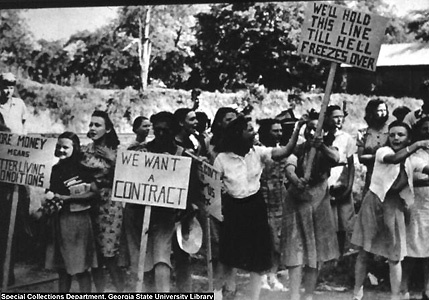Labor History In 2 Mins., Rick Smith Show: Sept. 6, 'Bloody Thursday' 1934 Textile Strike
Last edited Tue Sep 7, 2021, 07:30 AM - Edit history (2)

- Textile Workers Strike (1934).
The textile workers' strike of 1934 was the largest strike in the labor history of the United States at the time, involving 400,000 textile workers from New England, the Mid-Atlantic states and the U.S. Southern states, lasting 22 days.
- The background to the strike: Textile strikes. The textile industry, once concentrated in New England with outposts in New Jersey and Philadelphia, had started moving South in the 1880s. By 1933 Southern mills produced more than seventy percent of cotton and woolen textiles in more modern mills, drawing on the pool of dispossessed farmers and laborers willing to work for roughly forty percent less than their Northern counterparts. As was the rest of economic life, the textile industry was strictly segregated and drew only from white workers in the Piedmont. Until 1965, when passage of the Civil Rights Act broke the color line in hiring, less than 2% of textile workers were African American.
Throughout the 1920s, however, the mills faced an intractable problem of overproduction, as the wartime boom for cotton goods ended, while foreign competition cut into their markets. Although manufacturers tried to reduce the oversupply by forming industry associations to regulate competition, their favored solution to the crisis was to squeeze more work out of their employees through what workers called the "stretch-out": speeding up production by increasing the number of looms assigned to each factory hand, limiting break times, paying workers by piece rates, and increasing the number of supervisors to keep workers from slowing down, talking or leaving work.
The stretch-out sparked hundreds of strikes throughout the Southeast: by one count, there were more than 80 strikes in South Carolina in 1929 alone. While most of them were short-lived, these strikes were almost all spontaneous walkouts, without any union – or other – leadership. That year also saw the massive strikes that began in Gastonia, North Carolina, and Elizabethton, Tennessee, which were violently suppressed by local police and vigilantes...
https://en.wikipedia.org/wiki/Textile_workers_strike_(1934)

- Sept. 3, 1932, progressive miners of America founded.



